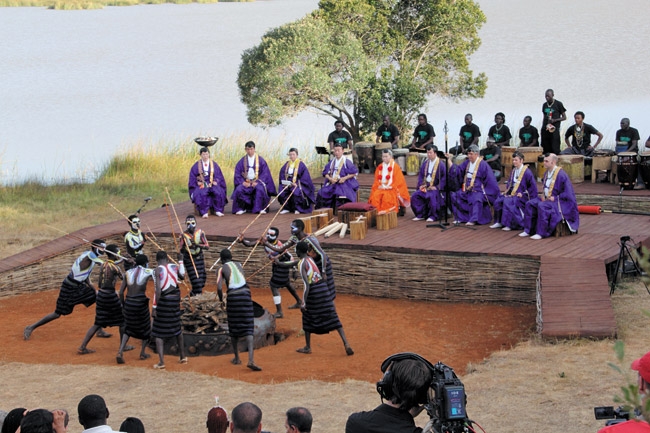Lady of the Lanterns
“This lantern floating ceremony is something we do in Japan in obon time, (in the summer) when we remember our ancestors. But I wanted to find a date Americans would be familiar with. So I gave a lot of thought to how can we bring this Japanese tradition to people in Hawaii in a meaningful way. How to bring these two elements, two traditions together?”
The perfect answer was Memorial Day.
“There is something you can feel only by floating your own lantern, and I want people to share this experience with many people, of setting their own lantern afloat,” she says. “It is such a moving experience. I want people to feel happy coming to the event. So now we have as many as 5,000 lanterns (up from 3,000 in past years).”
Japanese Buddhism is different from Tibetan Buddhism (and most other forms), in which priests and nuns are expected to remain celibate. In 1872, the Meiji government decreed priests could marry. When I mention to Shinso Ito that I understand she is married and ask about her husband, she giggles and says, “You are the first person who has asked me this question.”
She continues: “His name is Isao Ito, and he is chairperson of a Shinnyo-en foundation that works with senior citizens, to live their lives fully. In Hawaii, they have social welfare seminars.”
It was her father’s idea for her to marry, and he suggested three men, including Isao.
“Until then, I was trying to think of a good wife for him,” she says with a soft laugh.
“I have my own way of thinking, my ideas, and so I did not want (a husband) to influence my thinking on how I should be. And I also didn’t want to convince others by saying, ‘You have to live your life in this way or that way.’ I didn’t want to marry anyone who I had to convince you have to live your life in this way, or I have this way of thinking so you must, too. So I was happy to marry someone who understood what I believed in, what I am thinking, what I want to achieve in my lifetime.
“My father wanted me to be married, because of his idea to be able to help many people live their lives based on the Buddha’s teaching, and therefore he thought it was a good idea that I have a family.”
They were unable to have children, she says because she had a “health” issue, but the family includes several cats.
“We always had animals in our home when I was young, dogs and cats,” she says. “So, yes, I do have cats, and they represent all the creatures of the world. I am an animal lover.”
She is human, and has a weakness for dark chocolate, and was pleased with my omiyage gift of a few bars of Hawaii-grown and -made dark chocolate from Madre in Kailua.
While Her Holiness hopes to continue leading Honolulu’s Lantern Floating Ceremony for many years and her health is good, she just turned 71. “The true nature of things” being a core concept in Shinnyo-en, she is laying plans for a future without her. Thus, in the days before I arrived in Tachikawa, she named her successor-designate, Rev. Takashi Torikai.
“Right now, every year in Hawaii, lantern floating is very successful – many people come, and I want this to continue,” she says. “What I don’t want to happen is people say, ‘In the past there was a spiritual community from Shinnyo-en and they used to hold such a beautiful ceremony at Ala Moana Beach Park.’ That definitely is what I don’t want to happen. So this is what I am telling him, that this is his responsibility to make sure this will not happen.”
Rev. Torikai has strong local ties as former board chairman of Na Lei Aloha Foundation, the secular wing of Shinnyo-en in Hawaii responsible for organizing lantern floating.
“His mother came to Shin-nyo-en when he was a college student, a pharmaceutical science major, and he earned a Ph.D.,” she says. “He started working with Shinnyo-en after that, serving my father very closely for some time. He has always been such a dedicated practitioner.
“He is only 11 years younger, so he tells me, ‘Maybe I will go before you do.'”
She laughs softly again, smiles contentedly, knowing Shinnyo-en – and Lantern Floating in Honolulu – will be in good hands for years to come.
And, living in the present, she is delighted to return to Hawaii for another Lantern Floating Ceremony, giving life to her father’s prayer and joy to thousands of people.
“When we act for the sake of others, it gives rise to joy,” Her Holiness says. “Mutual understanding is a result of our efforts to expand the practice of loving kindness and altruism, starting with those around us. I believe that such efforts will ultimately lead to lasting peace in the world.”
What Is Shinnyo-en?
In 1971, the first Shinnyoen congregation outside Japan was founded in Mililani. Two years later a temple was established at the corner of Isenberg and Beretania. Today it boasts about 4,000 members, led by lay Rev. Craig Yamamoto, a Mililani High and UHManoa grad. Previously he worked as a plant quarantine inspector for the state Department of Agriculture, searching incoming shipments and occasionally making the news when he discovered a snake or iguana.
While Shinnyo-en belief is based on traditional Buddhist teachings, and its founder Master Shinjo Ito studied at Kyoto’s Daigoji monastery that traces its lineage back to the year 874, he also wanted to create a Buddhism for the modern world.
Lay ministry is emphasized over a priestly one. “He always valued tradition,” Her Holiness Shinso Ito says of her father. “But at the same time, you could easily guess because of his background as an engineer, he was the kind of person who was able to look ahead of time, he was thinking ahead, and he wanted to adjust the time-honored tradition of Buddhism based on the needs of the people at that time. He was able to take the teachings that have such a long tradition and make them accessible to the people of today. For example, (at certain ceremonies) I wear traditional robes. But if everyone has to dress in that way to train, it would be impossible. So he made it possible – he came up with ways for people of today, who have families and jobs, to train in their own circumstances. He brought the Buddha’s teachings to modern people. That is the secret of why Shinnyo-en now is accepted by many people.”
In Shinnyo-en, unlike some other forms, there are no “hermitage” retreats to mountaintops for months or even years of silent study. Shinnyo-en is very much in this world. An essential part of Shinnyoen practice is active volunteerism, and pursuing inter-faith dialogue, which includes lantern floating.
Here is a brief teaching for MidWeek readers from Her Holiness Shinso Ito on the meaning of Shinnyoen: “Shinnyo means the true nature of all things. En means a boundless garden without walls or fences.
“Practically, it means there are different people in this room, each different, and we want to recognize that. And each of these people has a Buddha nature, their own Buddhaness, and it takes different expressions. To awaken and develop that Buddhaness, by encouraging them to do good for other people around them, that process is Shinnyo – in doing so they can become aware of their goodness as they are. En means it is open and available to all, without bounds.
“Lantern floating expresses Shinnyo-en, it shows what we are, our values.”
15th annual Lantern Floating Ceremony
May 27, Ala Moana Beach Park
Her Holiness Shinso Ito conducts the ceremony from 6 to 7:30 p.m.
Starting at 10 a.m., those wanting to personally float a lantern during the ceremony may receive a single individual lantern per family or group at the Lantern Request Tent located at the mauka-diamondhead end of the beach, on a first-come, first-served basis. Five-thousand lanterns will be available (up from 3,000 in past years). Lantern parts are given in a carrying bag. Quiet space is provided for writing remembrances and assembling the lantern. Pens are provided in the tent.
Free event parking is available at Hawaii Convention Center from 9 a.m. to midnight. A complimentary shuttle will transport passengers from the Convention Center to Ala Moana beach park beginning at 3:30 p.m., then back to the Convention Center from 7:45 p.m.
For more information, go to lanternfloatinghawaii.com.







